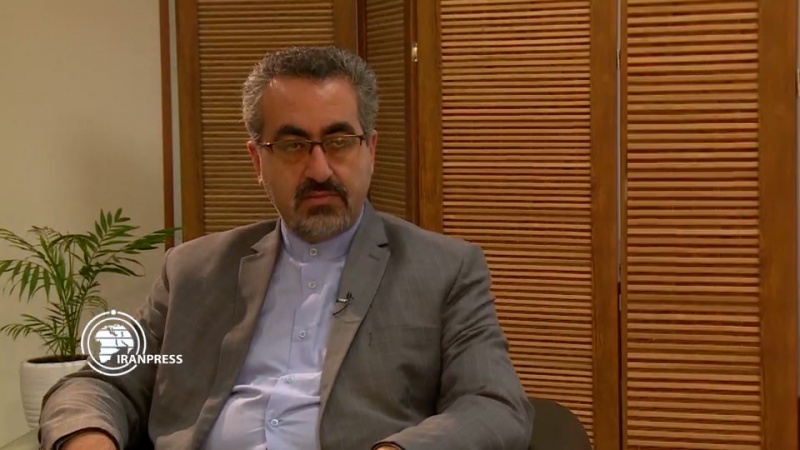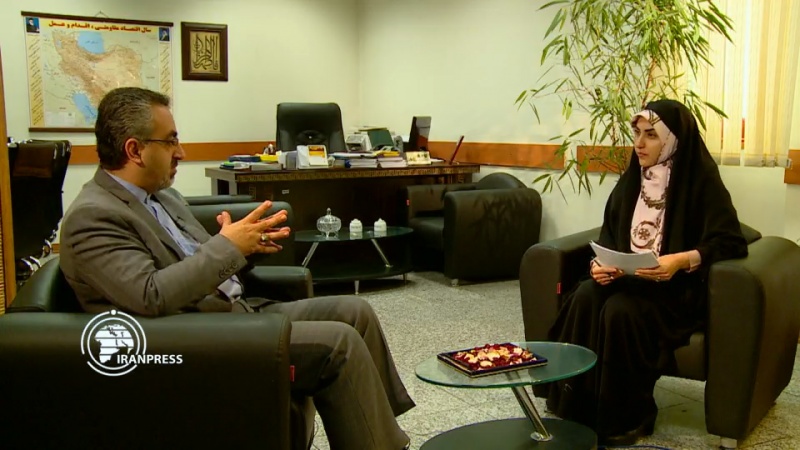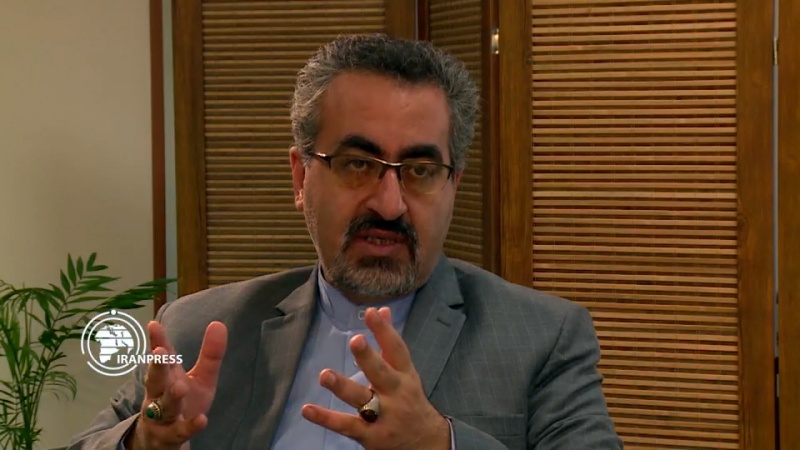Iran Press/ Iran News: Kianoush Jahanpour in a talk to Iran Press on the exact time of declaring the public about Coronavirus outbreak in Iran said that after 45 minutes of approving the first test in Iran it was shared with the media which is unique, and this bilateral trust helped us in the next steps.
About the validity on the news and statistics of COVID-19, Jahanpour stated that many people follow the news every day and what we share is what has been identified for sure, and nowhere in the world official statistics is based on guesses, but those with wrong intentions will not be convinced with medical statistics.
National Task Force for Combating Corona was our main plan for combating COVID-19 which has the most people's participation in three phases: the first phase is called modest social distancing which was the first four weeks; the second phase was significant social distancing and the third phase is smart social distancing since it is impossible to close the production sections longer, he declared.
More than 70 million people Screened
"Screening the infected ones and taking immediate action in National Task Force for Combating Corona is a sample for all the world", Jahanpour highlighted.
The official went on to say that a novel virus-like Corona, needs novel methods as well which are easy and available too, high-tech methods cannot be available for everyone. Screening people through the 4030 call system is one of these ways which screened more than 70 million people.
"We witnessed that countries with more powerful infrastructures, equipment and staff had more death toll and social anxiety than us, those catastrophes never happened in any parts of Iran," he added.
Health System improved significantly compared to previous epidemics
The spokesman for the Ministry of Health and Medical Education said that the Iranian health system has improved significantly compared with previous epidemics in dealing with screening and recording statistics.
"For more than 40 days, as the spokesman of the Ministry of Health, you have been informing people every day about the latest news and information about COVID-19, but the Western media believe that the number of deaths does not match to the infected patients reported from inside Iran. How much do you think the news and information provided by the Ministry of Health has been able to convince the public opinion? ," he said.
Jahanpour said: Most people follow the news. When we go among the masses, they both follow and accept. Because what we are presenting to the people has been confirmed and finalized, and this has been said to the people over and over again.
We're looking to find out the infected cases or possible cases of death, but what we're offering people is something that has been confirmed.
Certainly, we cannot and nowhere in the world, it is customary for the official statistics of the government or the health system to present statistics based on speculation. We make no secret of the fact that we are certainly cases that are suspicious cases that we identify.
 Corona is a historic catastrophe for Western health system: Jahanpour
Corona is a historic catastrophe for Western health system: Jahanpour
Jahanpour added: There are cases that refer to us or we went to them in the national mobilization plan against coronavirus and screening system. And we identified these in the health system as suspicious and referred them to health care centers. And they may even be hospitalized, but those numbers don't necessarily mean they're definitely infected with COVID- 19. What we can present to people is confirmed in infected cases.
And I think there are countries around the world that may be systematically delaying or hiding information for some reason, in this regard. But we certainly know them, even in our own region and we know which countries are providing true information. In some Western European or Southern European countries, and even in North America, 10 or 11 percent of cases have died, which is not possible.
And it is a historic catastrophe for their health system, and we are sure that this is not the case, and 10 percent of the cases have not died, but ten percent of the known cases of infected patients have died. Today, if anyone wants to say that the statistics of any country are transparent, this is not the case compared to us.
The discrepancy between the number of deaths and the number of cases reported by the health system of all countries contradicts this mismatch. These do not necessarily lack transparency in presenting their statistics, however, they are in the throes of an epidemic and cannot detect all or most of the cases.
Iran's Ministry of Health spokesman added: In fact, cases with severe symptoms are usually identified, normally, the number of people who may die might increase, Therefore, the objection that may be made to us or even to some other countries about the totality of statistics is not a scientific, technical and epidemiological point of view from the perspective of the health system. These claims of discrepancy generally are politically motivated.
And you can present any number and in any way, however, you can't satisfy those who have political motives with medical statistics and health and epidemiology. This is another matter, and we don't deal with it much. And, of course, we do not asses the statistics of vital health and epidemiology statistics with political criteria.
According to our epidemiological criteria, fortunately, the approach of the health system regarding informing the public and recording data and collecting our statistics is good. Of course, we are aware of the shortcomings and we will definitely improve this path because we believe that informing and collecting corona data has improved compared to many previous epidemics in Iran. And we will continue to do so in the future.
 Through smart, social plan Iran prevents disaster unlike elsewhere
Through smart, social plan Iran prevents disaster unlike elsewhere
Iran's Ministry of Health spokesman, Kianoush Jahanpour said: "The country through implementing a three-phased plan against coronavirus, set by 'National Task Force for Fighting Coronavirus, which was based on the social approach and public participation succeeded to prevent the disaster that happened elsewhere in the world."
In response to Iran Press News Agency regarding the plan that the Ministry of Health and Medical Education implemented to contain the novel coronavirus the spokesman of the ministry Kianoush Jahnpour stated, "The Ministry of Health did not present various plans, but we had a comprehensive national program called the National Mobilization Project to fight the Coronavirus.'
Through a convincing explanatory social approach, we could be able to fight the virus by attracting public participation and convincing them to follow the health guidelines.
And we can fight the virus as long as society is convinced. Of course, we believed that government intervention could be as effective as 15 to 20 percent, however, we considered more than 80% of the role played by the people and society which would be crucial.
With this approach, the path chosen by the Ministry of Health was a three-phased one that was named in terms of the time period it took for implementation, the beginning phase was 28 days after the first case was identified by the Ministry of Health.
When the outbreak happened in some provinces
At that time we were certain to have a disease outbreak in some provinces. In the first 28 days or the first four weeks, we implemented moderate social distancing according to the adopted approach. In this phase, we closed the country's schools and universities, and by doing so, we prevented nearly a quarter of the country's population from attending public places.
The rest of the combat was voluntary, and the spontaneous act of people in the society itself took a moderate social distancing through their own will.
In the next 28 days or the second phase of the plan coincided with the first weeks of the Iranian new year, the Ministry of Health has implemented significant social distancing.
This phase witnessed more social restrictions imposed by the government, such as restrictions on the commuting of citizens, especially restrictions on long-distance travel, which were added to the first phase of social distancing measures.
From the end of April or the third phase of the plan, we will enter the third phase or smart social distancing, which can take at least 4 weeks and if necessary it would take much longer.
Iran's Ministry of Health spokesman, Kianoush Jahanpour, said: Due to the fact that it is not possible to continue the closure of economic activities, production, and various industries, thus it would be necessary that we definitely reduce the restrictions so that industries and businesses can operate with the priority of production.
Assessments of the return on economic activity have been made by the 'National Task Force for Combating Coronavirus" and with the priority given to the production sector, three categories of essential or low-risk jobs, jobs with relative importance and non-essential jobs, have been categorized, as a guideline for restoring the economic activities.
In this regard, using a variety of methods, including the development of PCR laboratory tests and molecular and cellular tests, we can give people a better health certificate to get back to work.
At the same time, a protocol has been prepared for the various categories of jobs that have been mentioned, and each gild and union in charge, monitors its implementation, at the same time it is monitored by the Ministry of Health along with the Judiciary, and violators of the protocols will be dealt with through legal measures.
These protocols have specified the social distancing needed according to each guild so that it is possible to practically get out of this phase of job closure and restoring the economic activities.
 Iran's model to fight corona could be a model for the world: Jahanpour
Iran's model to fight corona could be a model for the world: Jahanpour
Head of Public Relations and Information Center of the Ministry of Health Kianoush Jahanpour regarding the Iran Press News Agency question said that the model used by Iran and the success of the Ministry of Health in screening 70 million Iranians through the 'National Mobilization Project to fight the Coronavirus' could be a model for the world.
One of the characteristics of the epidemic diseases is that a large number of people in society will be affected, and certain methods should also be used to control and contain epidemics. Reliance on technology-based methods is not widespread and these methods based on high techs will not be available to everyone in developing countries, at least for a limited time.
Thus adopting methods with a social approach that is widespread and accessible to all, would lead to the effectiveness of these methods, which is important in containing the epidemics.
One of these methods was screening, which began in Iran with a large call system through which the Ministry of Health responded to the public and helped the people to get familiar with the coronavirus.
The platform was used to screen individuals and identify patients so that patients could be referred to healthcare centers very soon.
In the health service centers, the clinical information of the people was checked and if necessary, the people were directed to the hospital. Preliminary examinations of the clinical symptoms were performed at this stage so that the hospitals would not be crowded.
Nearly two-thirds of those referred to these centers were quarantined or isolated at home and were monitored for up to five days by health officials.
Role of National Screening and Care System in fighting Coronavirus
At the National Mobilization Project, we used to get people's degree of satisfaction during the screening and medical process to get feedback so that both the society would be reassured and the recovery process would be improved.
Within a week or two, we saw the results of this operation by reduction of the numbers visiting different health centers or emergency hospitals, and by monitoring early symptoms of people, detection with this system was effective and inexpensive, leading to early diagnosis and action by National Mobilization Project to fight the Coronavirus.
Iran's Ministry of Health spokesman, Kianoush Jahanpour, said: Compared to other countries that are in a better position in terms of medical facilities and have more diagnostic procedures and test kits than Iran, statistics show that the number of patients and deaths they have experienced is much higher in terms of inflictions and fatalities than Iran.
This significant achievement was done in Iran more than anything by a national mobilization against the Coronavirus and in particular the National Screening and Care System.
Relying on the network of the Iranian healthcare system, which also covers the most remote villages of the country, through the network-based system has led to disease management and containment.
Although we now have cases of the disease, the course of the process is a relatively stable trend, however, what happened elsewhere in the world did not happen in Iran.
Human society will defeat this disease by taking joint action and following health guidelines such as staying at home, Jahanpour concluded.
104/205
Read More:
Iran's recovered COVID-19 patients exceed 57,000
Hossein Vaez

